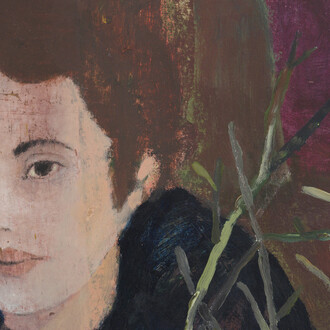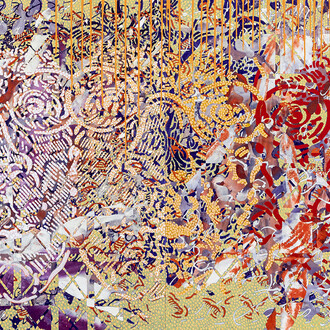It’s not every day that you hear about a painter trying to turn the medium of painting on its head. But such is the curious case of Alun Williams, a British painter who spends considerable time orchestrating chance encounters with art history on the streets of Europe and North America. Taking inspiration from an iconoclast like Francis Picabia, who in 1920 univocally declared a Rorschach-like inkblot to be La Sainte Vierge (The Blessed Virgin), Williams roams the lanes and byways of major cities and minor towns resolutely declaring random paint marks on buildings to represent major historical personages.
Like the French Dadaist, Williams banks on the sheer irrationality attached to painterly illusionism to give history painting a final conceptual turn of the screw. If a naturalistic arrangement of color on a piece of cloth can represent world historical figures, he argues, then a few especially suggestive abstract splotches can be made to stand for disparate characters that have animated this or that place on the globe. Taken literally, the artist’s wildly associative method is capable of turning an innocent walk to the corner store into an encounter with seventeenth century nobles, eighteenth century radicals and the everyday men and women whom capitalized History often overlooks.
This, in fact, is exactly how Williams has come to paint characters as disparate as the American revolutionary John Adams (a man who led multiple lives, he became the second President of the United States at the age of sixty-two), dreamer-novelist Jules Verne (the artist claims the writer “travelled in time and space” while anchored to his armchair), poet and short-story writer Edgar Allan Poe (a disputed letter attributed to Alexandre Dumas documents a purported visit by the American to Paris), Julie Bêcheur (differing historical accounts identify a prominent market seller at Les Halles before 1789, but agree on virtually nothing else), Hester Leisler (the first daughter of the short lived “King of New York,” she lived a long life even after her father was put to the sword for treason by King William), and the legendary matchmaker Marguerite Bourgeoys (she put together the world’s first “marriage agency” for the largely overlooked “Filles du Roy”—some 800 young French women who immigrated to New France at the behest of Louis XIV to literally beget the population of Canada).
Represented in nearly every case by painted shapes Williams places into extensively researched backgrounds— his portraits of individual “Filles de Roy” are represented via art historical quotations—his characters acquire newfangled abstract forms that match the unstable circumstances of their rediscovery. As the artist put it in one interview, he actively upends historical portraiture (and representation itself) by relating his portraits to, among other willful artistic ideas, the idea of camou age. Rather than pursuing colored shapes that become invisible—as suggested by the term camou er, for to disguise—his own cussed practice consists above all of making the invisible visible. After seeing his time-bending historical portraits you will never look at random marks or graf ti the same way again.
Alun Williams was born in 1961 in Manchester (UK). He lives and works in New York. He exhibited his work for the first time in 1979 at the University of Manchester and in the same year left to study painting at the School of Art of the University of Wales. In 1981-82 he bene ted from an overseas study grant to begin his long relationship with France as a student at the National Art School in Bourges. He finished his studies in Wales, had a solo exhibition at the Galerie Medamothi in Montpellier, then continues studying at Blackheath School of Art in London before beginning his Masters at Goldsmiths’ College (1986-87).
At this time, he exhibited notably at Maureen Paley (Interim Art) in London, as well as at the Museums of Stoke- on-Trent and Peterborough (UK). He undertook a residency and solo exhibition at the Art School of Nîmes (France), as well as at different venues and galleries in London. In 1991, he traveled to the USA and Canada, for a series of lectures and residencies. In 1992, with Isabelle Viallat, he created the Association La Vigie in Nîmes, and in 1993 he joined the Board of Directors of the Triangle Arts Association in New York. In 1995 he was the founder, with Claire Lesteven and Bernard Plasse, of the Triangle France Association, in Marseille at the Friche Belle de Mai. Since 1998, he has been based in New York, and in 2000, he was the founder of Parker’s Box, in the artist-run gallery neighborhood in Brooklyn.
Today, while concentrating his energies on his own painting practice, Alun Williams continues his involvement in the experimental projects undertaken by Parker’s Box, Brooklyn and supports the activities of Triangle in New York and closely follows those of Triangle France in Marseille and La Vigie in Nîmes. He is also a long-distance runner and member of the New York Road Runners Club and North Brooklyn Runners. He recently exhibited his work at Frac Limousin (France), Smack Mellon (New-York), gallery Pierogi (New-York), also at the University of Quebec in Montreal, Museum of Modern Art and Contemporary Art of Nice and at the Maeght Foundation (Saint-Paul-de-Vence).
Lest, his monograph was published in 2011 in the Publishing Manuella, with texts by Cheyney Thompson and Eric Mangion.
















